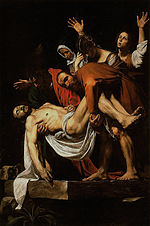This article has multiple issues. Please help improve it or discuss these issues on the talk page. (Learn how and when to remove these messages)
|
| Part of a series on |
| Death and Resurrection of Jesus |
|---|
 |
|
Portals: |
The Lost body Hypothesis tries to explain the empty tomb of Jesus by a naturally occurring event, not by resurrection, fraud, theft or coma. Only the Gospel of Matthew (28:2)[1] mentions a 'great earthquake' on the day of Jesus' resurrection. The preceding crucifixion quake was accompanied by darkness, splitting of the rock and opening of graves (Matthew 27:51).[2] In this way, a crack in the rock is purported to explain the empty tomb on resurrection day; the body of Jesus fell into a crevice produced by the earthquake and the crack closed again because of the aftershocks.[3]
The Gospel of Matthew in this theory is seen to be hinting at the earthquake events in verse 12:40:[4] the Son of Man descending for three days in the heart of the earth, like Jonah was in the whale's belly. The Gospels of Mark and Luke do not mention a quake, but only darkness at noon, splitting of the temple veil and the tombstone rolled away. John in his Gospel (12:24)[5] and Paul in his Letters (1 Corinthians 15:36)[6] used the image of a grain of wheat falling in the earth for the event of death and resurrection of Jesus.